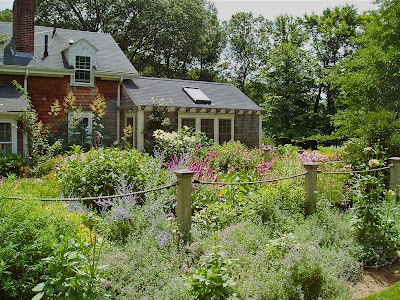
As August approaches the gardens here in Seekonk have settled into their mid-summer rhythm. Though I may occasionally fill a bare spot with a showy annual or two (make that an even half dozen), most of my time these days is spent on routine maintenance. While it's true that autumn's tawny seed pods have a certain romantic charm, during the blowzy dog days faded petals and browning stems can make the garden look tired and disheveled. Deadheading, the process by which old flowers are removed with scissors or pruning shears, is the best way to keep plants looking fresh, giving the landscape, as it were, a horticultural face lift.

In addition to the purely aesthetic benefits, removing spent blossoms from certain plants will often prolong the bloom cycle or encourage another flush of flowers later in the season. For annuals like zinnias, dahlias, and cosmos deadheading is absolutely necessary to ensure that the plants remain in bloom until frost. Certain perennials: heleniums, monardas, and rudbeckias, for example, also benefit from this practice. And while it can be time consuming, I find that removing the dead flower heads from summer-blooming shrubs like spireas and buddleias reliably extends flower production.

Because seed production diverts energy from the mother plant, flowering bulbs like daffodils and lilies also benefit from deadheading. Since bulbs generally bloom only once a year, however, you won't reap the benefits of your labor until the following spring when you'll be rewarded with larger and more prolific plants. Of course, if you want your plants to self-sow, at least a few seed heads should be allowed to reach maturity. I often encourage biennial and short-lived hollyhocks, lychnis, foxgloves, and columbines to set seed, ensuring that I have a continuous supply of new seedlings every year.

Though not technically "deadheading", I also make a habit of discarding dying or discolored foliage. Removing brown leaves serves both an aesthetic and functional purpose. In addition to detracting from the garden's beauty, dying leaves may carry and spread mildew and other diseases.

I'm enormously fond of daylilies and have planted several large groupings in the the gardens here. Unfortunately, I find that as the plants reach the end of their bloom cycle, their foliage begins to brown out. By August, what was once a lovely mass of grassy vegetation crowned with bright blooms has become an unsightly tangle of dying leaves topped by brittle faded stems.

A few years ago I discovered that, if I grabbed a handful of the browning leaves by their tips and yanked upward, the old foliage easily came away revealing new green shoots near the soil line. Subsequently, I realized that I could simply cut the plants almost to the ground once they've finished blooming. Though this drastic measure produces an unappealing bald spot in the garden for a few weeks, the plants soon throw new growth that remains fresh until hard frost.

The next time you have a few minutes to work in your garden bring a pair of pruning shears and trim away the dead flowers.
You'll be glad or should I say grateful that you did.

Wow you did a great job on your garden. I love those plants you've planted on the mini ponds.
ReplyDelete